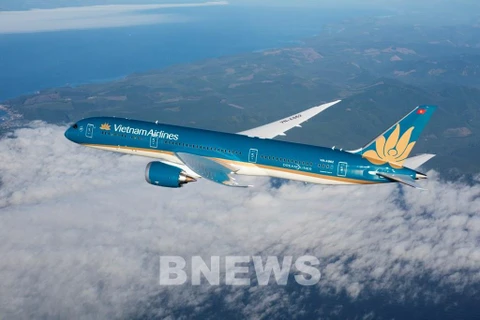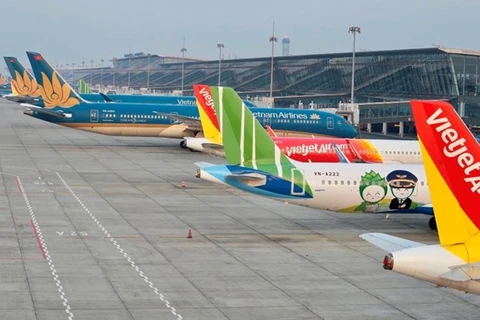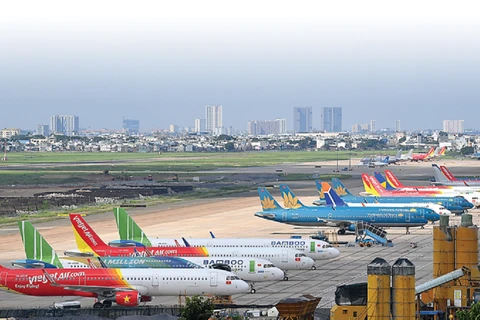 Vietnamese airlines have enjoyed better business results on the back of the tourism sector’s strong recovery. (Photo: VNA)
Vietnamese airlines have enjoyed better business results on the back of the tourism sector’s strong recovery. (Photo: VNA) Revenue jumps, loss narrows
According to the General Statistics Office of Vietnam and the Vietnam National Authority of Tourism, Vietnam welcomed 8.9 million foreign arrivals during January – September, up 4.75 folds from the same time last year. Of the total, more than 6.1 million came to the country by air, increasing 3.7 folds year-on-year.
With the tourism sector bouncing back, domestic airlines have enjoyed robust business results.
The consolidated financial report from the Vietnam Airlines Joint Stock Company (Vietnam Airlines) showed that the airline’s turnover in Quarter 3 rose 11.7% year-on-year to more than 23.75 trillion VND (981.6 million USD), marking an eight-quarter streak of recovery.
During January-September, the company gained nearly 68.1 trillion VND in revenue, rising 32.5% year-on-year. Meanwhile, it ran at a loss of more than 3.5 trillion VND, which was half of the figure recorded in the same time last year.
The Vietnam Airlines Group, which comprises national flag carrier Vietnam Airlines, Pacific Airlines, and Vasco, operated over 114,000 flights, and transported more than 18 million passengers during the period, according to the Civil Aviation Authority of Vietnam (CAAV).
Although Vietjet Air reported a surge of 25% in its revenue in Quarter 3, it is taking on formidable challenges.
Meanwhile, Bamboo Airways continued to adjust its flights for the year-end period with the suspension of various international flights from Hanoi and Ho Chi Minh City to overcome the rough times.
Airlines need support to improve competitive edge
Despite strong recovery, domestic airlines has yet to reel in profits as airfares could not outpace expenditures.
the Vietnam Airlines Group’s domestic tickets in June fell 6.6% as compared to the same month of 2019 – before the COVID-19 pandemic broke out.
The ceiling for airfares has been kept unchanged since 2015 while input costs such as fuels and exchange rates have fluctuated, leaving a negative impact on airline business results, Vietnam Airlines said.
Vietnam Airlines spending on fuels last year surged 30.5% from 2015 – the time when the ceiling airfares were applied since average fuel prices rose 85% to 124.46 USD per barrel in 2022 from 67.37 USD in 2015.
“Airline carriers incur 70% of costs in foreign currencies. Ticket revenue is in VND, JPY and KRW, which are all falling against USD. Therefore, currency fluctuation risk has affected their business performance. The USD/VND rate rose 6.6% from 21,900 VND in 2015 to 23,350 VND 2022, causing Vietnam Airlines spending to increase 4.35%”, a representative from the national flag carrier said.
According to insiders, the aviation sector needs support from the Government, relevant ministries and sectors, as well as the supply chain of both tourism and aviation sectors so as to carve out better performance.
In the long term, experts said it is necessary to lift the airfare cap, which have been placed on domestic routes, to help airlines improve revenue and profits. However, the removal requires the amendment of the law on civil aviation and the law on prices that could take a long time. Bottlenecks should be removed soon so that airlines could survive until the end of 2024 when the market is on full recovery.
Vietnam Airlines proposed extending airfare caps in short term, creating favourable conditions for airlines to improve capacity and competitive edge.
It suggested imposing floor prices for domestic tickets based on the operation model of each airline to create a sustainable competitive environment for airlines, and ensure rights and benefits for passengers./.
the Vietnam Airlines Group’s domestic tickets in June fell 6.6% as compared to the same month of 2019 – before the COVID-19 pandemic broke out.
The ceiling for airfares has been kept unchanged since 2015 while input costs such as fuels and exchange rates have fluctuated, leaving a negative impact on airline business results, Vietnam Airlines said.
Vietnam Airlines spending on fuels last year surged 30.5% from 2015 – the time when the ceiling airfares were applied since average fuel prices rose 85% to 124.46 USD per barrel in 2022 from 67.37 USD in 2015.
“Airline carriers incur 70% of costs in foreign currencies. Ticket revenue is in VND, JPY and KRW, which are all falling against USD. Therefore, currency fluctuation risk has affected their business performance. The USD/VND rate rose 6.6% from 21,900 VND in 2015 to 23,350 VND 2022, causing Vietnam Airlines spending to increase 4.35%”, a representative from the national flag carrier said.
According to insiders, the aviation sector needs support from the Government, relevant ministries and sectors, as well as the supply chain of both tourism and aviation sectors so as to carve out better performance.
In the long term, experts said it is necessary to lift the airfare cap, which have been placed on domestic routes, to help airlines improve revenue and profits. However, the removal requires the amendment of the law on civil aviation and the law on prices that could take a long time. Bottlenecks should be removed soon so that airlines could survive until the end of 2024 when the market is on full recovery.
Vietnam Airlines proposed extending airfare caps in short term, creating favourable conditions for airlines to improve capacity and competitive edge.
It suggested imposing floor prices for domestic tickets based on the operation model of each airline to create a sustainable competitive environment for airlines, and ensure rights and benefits for passengers./.
VNA























